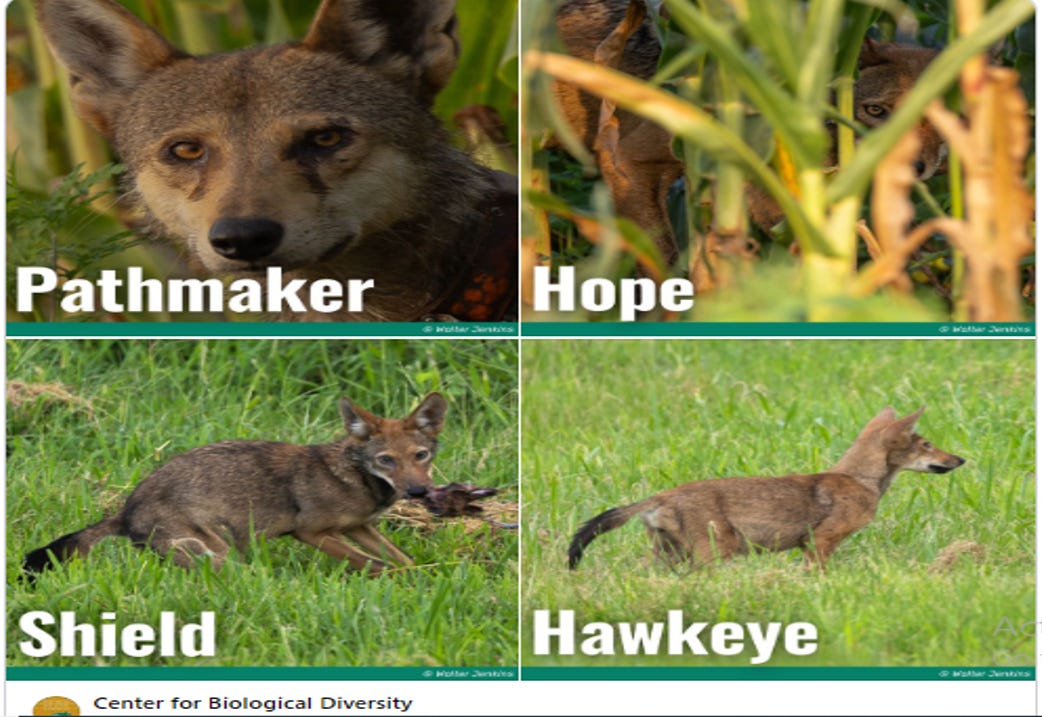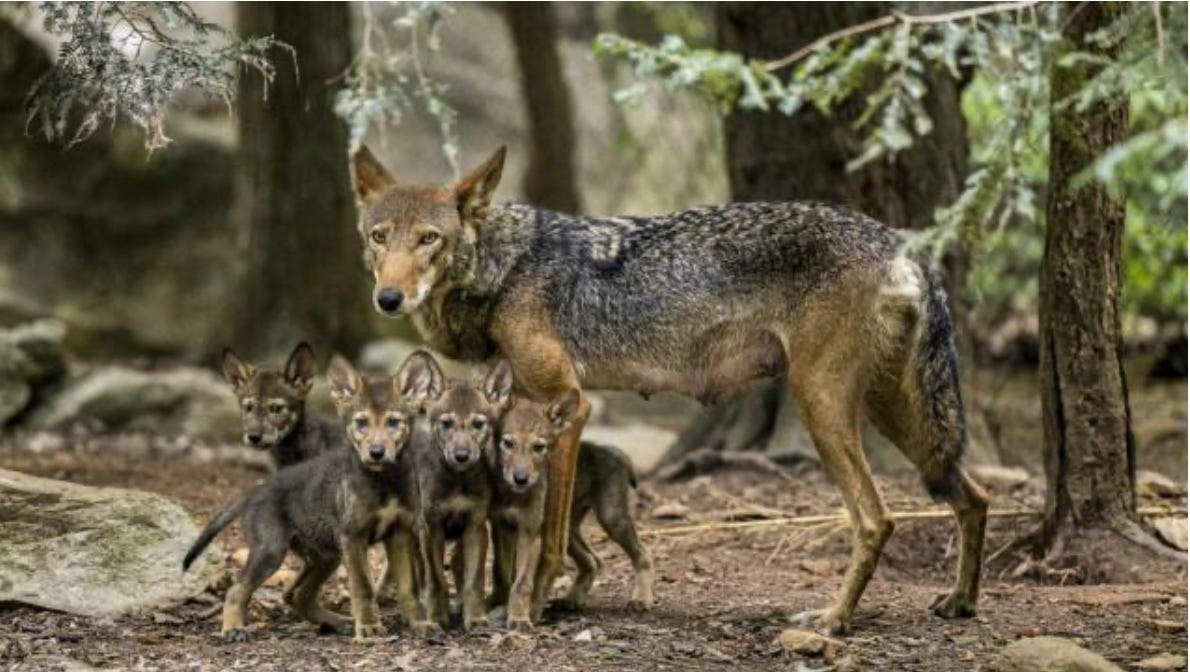Photo Credit: Center for Biological Diversity
The Center for Biological Diversity issued a press release announcing that the Tuscarora Indian Tribe of North Carolina has given names to the Red Wolf pups of the Alligator National Wildlife Refuge on May 1, 2024.1
A story about cute puppies is hard not to love. Unfortunately, not everyone agrees.
I have written about the Red Wolf Recovery program, about the complete disregard of the law by Department of Interior/Fish & Wildlife Agency personnel in allowing the killing of these wolves.2 I have also written about the recovery program and the hope it brings to re-establishing the wolves.3 In this article, I want to explore the symbolic nature of naming wolf pups in the wild.
Naming
Naming is a human activity, at least as far as we understand. Indigenous peoples have named the animals since the dawn of language, and often add familial titles to their name. Biblical references to naming begin with the very opening verses of the Bible:
Genesis 2:19
"So out of the ground the Lord God formed every beast of the field and every bird of the air, and brought them to the man to see what he would call them; and whatever the man called every living creature, that was its name"
——-Genesis 2:19
Naming recognizes existence. Linnaeus is credited with the naming of living things using Latin in a structure that gives names based on genus and species. For example, canis is the genus for the red wolf and rufus is the species; however there is long disagreement over whether the red wolf is a species or a subspecies of the wolf.4 Paleontological evidence showed its existence in Florida at least 10,000 years ago, and no signs of being a wolf-coyote hybrid as some claim.5 Nonetheless, it had a scientific name by 1851 and so it existed in the world of science.
Status of the Red Wolf
The Red Wolf is listed as endangered under the Endangered Species Act;6 but a lesser endangerment standard for the state of North Carolina— threatened.7 Most certainly a political decision (although it should not be) and because the research on red wolves does not support anything less than endangered.
In 1967, the precursor of the Endangered Species Act of 1973, the Endangered Species Preservation Act, included the red wolf as “threatened with extinction”.8 As of April 2024, the U.S. Fish & Wildlife Service estimates that there are about 18-20 red wolves in the wild in North Carolina, with captive breeding populations of 257.
Among the captive breeding locations of which there are about 41, the North Carolina Zoo in Asheboro, NC is one of them. NCSU (my Alma mater), part of red wolf recovery since 2001,9 just announced this week that the birth of three pups in their captive breeding program has been successful for the two weeks which is a test of survival.
Photo credit10
Sadly, one of the first of six pups born in the wild, now two years old, was killed by a car on highway 64 that runs through their protected habitat in North Carolina April 15, 2024. The 2-year-old had taken on the role of protecting his mother and siblings after his father was also killed in the same area by a car.11
North Carolina could build wildlife crossings that would obviously help save the lives of a population of less than 20 of the most endangered canides in the world.12
Naming wolf pups in captivity
Naming new born wolf pups is a great publicity tool for zoos for these pups born in captivity. The breeding program in the Tacoma, Washington Zoo, named the pups for plants and flowers in North Carolina (where they would ultimately be released). The Asheboro Zoo in North Carolina in 2021 named their six Red Wolf pups asking the public to select names from rivers in southeastern U.S. that used to be their habitat (Catawba, Edisto, Haw, Harper, Warrior, Eno, Fisher, Pearl, Waccamaw, and Swannanoa) 13
The Sioux Falls, South Dakota Great Plains Zoo, named their six red wolf pups born in their breeding program with Cherokee and Haudenosaunee languages names: Chesmu, Inali, Yaholo, Kajika, Imala, and Ajana, for example, meaning “Black Fox,” “One Who Yells,” and “Walks Without Sound,” among others.
Photo credit14
The meaning for the Tuscarora’s naming
The naming of the red wolves in the wild is deeply symbolic and meaningful. The Tuscarora Indian Tribe (though not a state or federally-recognized tribe) has many Tuscarora relatives who are members of the Lumbee Indian Tribe (a state-recognized and federally-recognized tribe with limitations). The region where the Red Wolves are being repopulated is in the traditional lands of not only the Tuscarora, but also the Algonquin Tribes (Chowan, and others). The efforts of the state and federal government to declare these Tribes and their descendants “extinct” continues despite those present who descended from them.15 The struggle for the survival of the bison is closely linked with the survival of the Lakota Indian Nations. Long ago, the Lakota say they made a promise to the bison that the bison would take care of the Lakota and the Lakota would reciprocate by taking care of them.16 The near extinction of the bison is analogized with the attempts to eliminate the Lakota from existence.
The near extinction of the Red Wolf has a strong association with the policies that were intended to kill or remove Native people in North Carolina, Virginia and South Carolina. In the coastal region, the Algonquin language Tribes were the first to encounter colonists and the first to be confronted with genocide and later claims of their disappearance. So this naming of the red wolf pups in the traditional lands of some of North Carolina’s indigenous peoples holds greater significance than the press release might indicate.
https://biologicaldiversity.org/w/news/press-releases/tuscarora-nation-of-north-carolina-names-four-endangered-red-wolves-2024-04-30/
https://open.substack.com/pub/profvictoria/p/can-the-red-wolf-survive-the-us-dept?r=bpwpi&utm_campaign=post&utm_medium=web
https://en.wikipedia.org/wiki/Red_wolf
https://bioone.org/journals/southeastern-naturalist/volume-1/issue-2/1528-7092(2002)001%5b0095%3aTOSOWI%5d2.0.CO%3b2/THE-ORIGINAL-STATUS-OF-WOLVES-IN-EASTERN-NORTH-AMERICA/10.1656/1528-7092(2002)001%5B0095:TOSOWI%5D2.0.CO;2.short
https://ecos.fws.gov/ecp/species/37
https://www.ncwildlife.org/conserving/species#8682104-mammals
https://www.fws.gov/project/red-wolf-recovery-program#:~:text=Status%3A%20First%20listed%20as%20%E2%80%9Cthreatened,Known%2Fcollared%20(wild)%3A%2017
https://news.cvm.ncsu.edu/howlelujah-3-critically-endangered-red-wolf-pups-join-nc-states-pack/
https://news.cvm.ncsu.edu/howlelujah-3-critically-endangered-red-wolf-pups-join-nc-states-pack/
https://myfox8.com/news/north-carolina/2-year-old-endangered-red-wolf-hit-killed-by-vehicle-on-nc-64-in-north-carolina/
https://www.nationalgeographic.com/animals/mammals/facts/red-wolf
https://www.wral.com/story/baby-naming-time-n-c-zoo-asks-public-to-help-name-six-red-wolf-pups/19732359/
https://www.wral.com/story/baby-naming-time-n-c-zoo-asks-public-to-help-name-six-red-wolf-pups/19732359/
https://www.nps.gov/articles/carolinaalgonquian.htm
Bison, our national mammal deserves protection
“For I am involved in mankind. Therefore, send not to know For whom the bell tolls, It tolls for thee.” John Donne, “No Man is an Island” These famous lines if revised to be reflective of Native American thought would say, “For I am involved in ‘creation’.” (beyond just humankind). The death of any part of nature …








